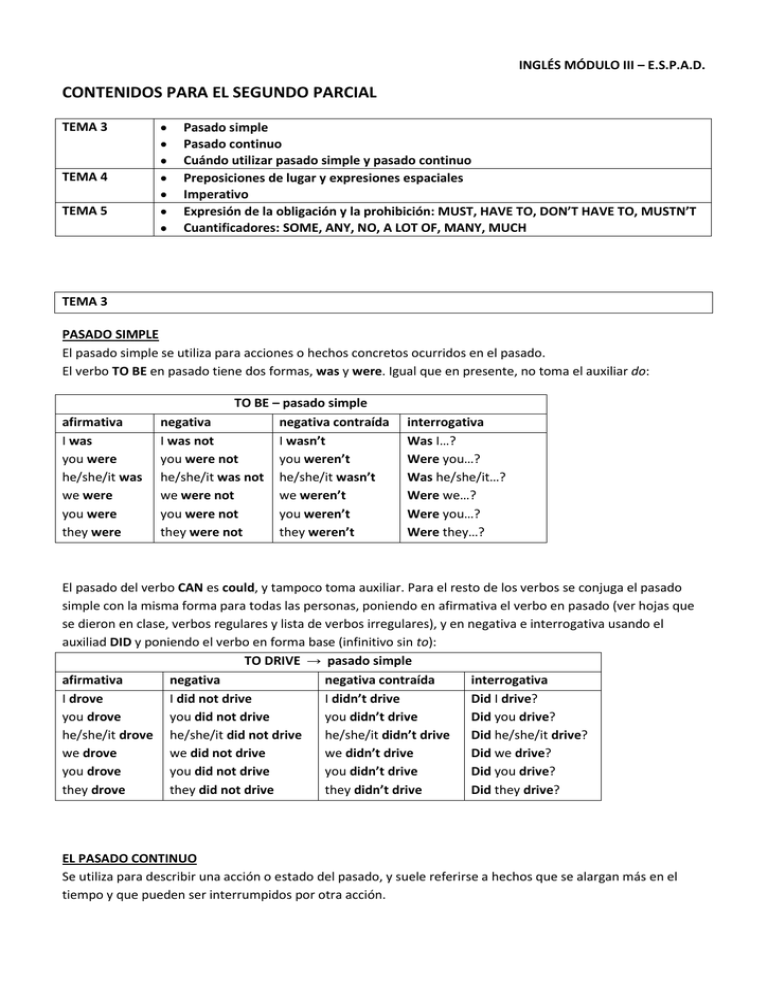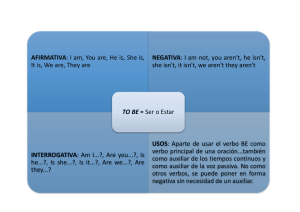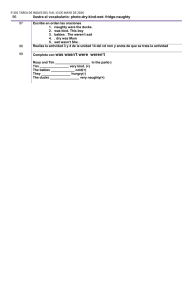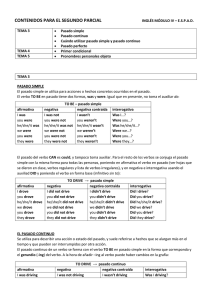Contenidos 2º parcial
Anuncio

INGLÉS MÓDULO III – E.S.P.A.D. CONTENIDOS PARA EL SEGUNDO PARCIAL TEMA 3 TEMA 4 TEMA 5 Pasado simple Pasado continuo Cuándo utilizar pasado simple y pasado continuo Preposiciones de lugar y expresiones espaciales Imperativo Expresión de la obligación y la prohibición: MUST, HAVE TO, DON’T HAVE TO, MUSTN’T Cuantificadores: SOME, ANY, NO, A LOT OF, MANY, MUCH TEMA 3 PASADO SIMPLE El pasado simple se utiliza para acciones o hechos concretos ocurridos en el pasado. El verbo TO BE en pasado tiene dos formas, was y were. Igual que en presente, no toma el auxiliar do: afirmativa I was you were he/she/it was we were you were they were TO BE – pasado simple negativa negativa contraída I was not I wasn’t you were not you weren’t he/she/it was not he/she/it wasn’t we were not we weren’t you were not you weren’t they were not they weren’t interrogativa Was I…? Were you…? Was he/she/it…? Were we…? Were you…? Were they…? El pasado del verbo CAN es could, y tampoco toma auxiliar. Para el resto de los verbos se conjuga el pasado simple con la misma forma para todas las personas, poniendo en afirmativa el verbo en pasado (ver hojas que se dieron en clase, verbos regulares y lista de verbos irregulares), y en negativa e interrogativa usando el auxiliad DID y poniendo el verbo en forma base (infinitivo sin to): TO DRIVE → pasado simple afirmativa negativa negativa contraída interrogativa I drove I did not drive I didn’t drive Did I drive? you drove you did not drive you didn’t drive Did you drive? he/she/it drove he/she/it did not drive he/she/it didn’t drive Did he/she/it drive? we drove we did not drive we didn’t drive Did we drive? you drove you did not drive you didn’t drive Did you drive? they drove they did not drive they didn’t drive Did they drive? EL PASADO CONTINUO Se utiliza para describir una acción o estado del pasado, y suele referirse a hechos que se alargan más en el tiempo y que pueden ser interrumpidos por otra acción. El pasado continuo de un verbo se forma con el verbo TO BE en pasado simple en la forma que corresponda y el gerundio (-ing) del verbo. A la hora de añadir –ing al verbo puede haber cambios en la grafía: afirmativa I was driving you were driving he/she/it was driving we were driving you were driving they were driving TO DRIVE → pasado continuo negativa negativa contraída I was not driving I wasn’t driving you were not driving you weren’t driving he/she/it was not driving he/she/it wasn’t driving we were not driving we weren’t driving you were not driving you weren’t driving they were not driving they weren’t driving interrogativa Was I driving? Were you driving? Was he/she/it driving? Were we driving? Were you driving? Were they driving? CUÁNDO UTILIZAR PASADO SIMPLE Y PASADO CONTINUO El pasado simple habla de hechos concretos o puntuales ocurridos en el pasado, mientras que las acciones expresadas en pasado continuo son percibidas como inacabadas o más dilatadas en el tiempo. Por tanto, si en una misma oración coinciden ambos tiempos, el verbo en PASADO CONTINUO se referirá a una acción que se alarga más en el tiempo (puede ir precedido de WHILE), mientras que el verbo en PASADO SIMPLE expresará una acción que la interrumpe (y puede ir precedido de WHEN). TEMA 4 PREPOSICIONES DE LUGAR Y EXPRESIONES ESPACIALES Pueden salir en el examen las preposiciones de lugar de las páginas 116 y 117 del libro, y las preposiciones y estructuras para indicar expresiones espaciales que salen en la página 121. EL IMPERATIVO El imperativo es el modo verbal que se utiliza para dar órdenes o instrucciones. Siempre está dirigido a una 2ª persona (you, es decir, tú o vosotras/os). En este modo verbal en inglés no se pone el sujeto. En afirmativa basta con poner el verbo en infinitivo sin to, y en negativa se pone don’t seguido del verbo: Come here → Ven/venid aquí Turn right → Gira/girad a la derecha Don’t make noise → No hagas/hagáis ruido Don’t smoke → No fumes/fuméis TEMA 5 EXPRESIÓN DE LA OBLIGACIÓN Y LA PROHIBICIÓN MUST: significa “deber”, y expresa obligación interna o subjetiva. Es un verbo modal, no toma el auxiliar do ni la -s de 3ª persona del singular, y va seguido de infinitivo sin to. I must study → Yo debo estudiar He must find a job → Él debe encontrar un trabajo HAVE TO: significa “tener que”, expresa obligación externa u objetiva, y va seguido de infinitivo. You have to go → Tú tienes que irte She has to work → Ella tiene que trabajar DON’T HAVE TO: significa “no tener que”, expresa ausencia de obligación, y va seguido de infinitivo.→ We don’t have to go to work → Nosotras no tenemos que ir a trabajar He doesn’t have to pay → Él no tiene que pagar MUSTN’T: significa “no deber”, expresa prohibición, y va seguido de infinitivo sin to. You mustn’t park here → Tú no debes aparcar aquí He mustn’t smoke → Él no debe fumar CUANTIFICADORES SOME indica cantidad indeterminada, y se usa en oraciones interrogativas y afirmativas: We need some salt → Necesitamos algo de sal There are some apples → Hay algunas manzanas Do you want some water? → ¿Quieres un poco de agua? ANY se usa en oraciones interrogativas y en oraciones con el verbo en negativa: Do we have any milk? → ¿Tenemos algo de leche? Are there any cars? → ¿Hay algún coche? I don’t want any sugar → No quiero nada de azúcar NO se usa en oraciones negativas cuando el verbo va en afirmativa: They have no time → No tienen tiempo There are no books → No hay libros A LOT OF se usa para cosas contables e incontables, generalmente en afirmativa: There are a lot of students → Hay muchos estudiantes He spends a lot of money → Él gasta un montón de dinero MANY se usa para contables, en afirmativa, negativa e interrogativa: There are many teachers → Hay muchos profesores You don’t have many problems → No tienes muchos problemas Do you have many friends? → ¿Tienes muchas amigas? MUCH se usa para incontables, generalmente en negativa: I don’t drink much coffee → No bebo mucho café


